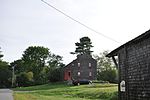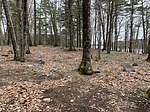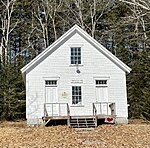Bustins Island

Bustins Island is an island in inner Casco Bay, Maine, United States. It is part of the town of Freeport. Although physically located within Freeport, the Bustins Island Village Corporation is a self-governing entity. The island has approximately 117 summer cottages, with the earliest dating to the 18th century. The island's main road is Bustins Island Road, which loops around the island for about 1.5 miles (2.4 km). It is bisected by offshoot roads. Every island building stands beside one of the roads, allowing for easy access for trash removal.The island operates its own ferry, the Lilly B, which debarks from the South Freeport town wharf. Typically, the ferry operates from Memorial Day weekend through Columbus Day weekend. The ferry arrives at public dock at the southwestern tip of the island, but there is also a steamer dock on the island's western side. A public landing ramp is located at the northern end of the island.The island's interior is undeveloped because it is part of a resource protection area, which comprises parcels of land that are now protected against development. It, as with the rest of the island, is under constant threat of fire. There is no pressured water on the island, and since all of the cottages are over one hundred years old, they can be easily set alight accidentally. Six houses have burned to the ground over the years, the last in 2007. Due to this risk, no open fires or fire pits are permitted.The island is named for John Bustion, while its ferry, the Lilly B, is named for Lilly May Brewer (1906–1977), who, along with her husband Ralph (1900–1968), was the caretaker of Bustins during the 1950s and 1960s.
Excerpt from the Wikipedia article Bustins Island (License: CC BY-SA 3.0, Authors, Images).Bustins Island
Geographical coordinates (GPS) Address Nearby Places Show on map
Geographical coordinates (GPS)
| Latitude | Longitude |
|---|---|
| N 43.800192 ° | E -70.07176 ° |
Address
04032
Maine, United States
Open on Google Maps









